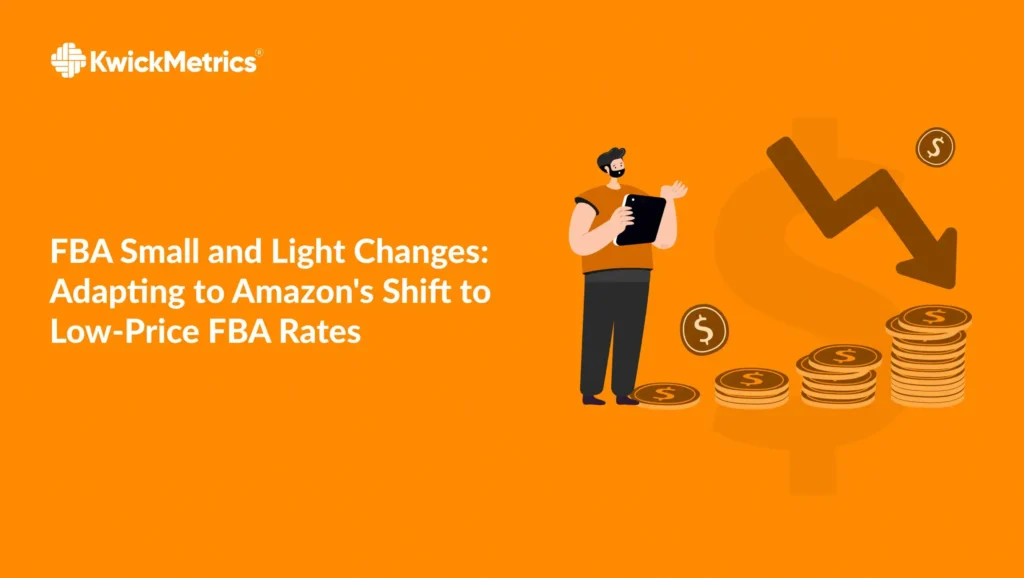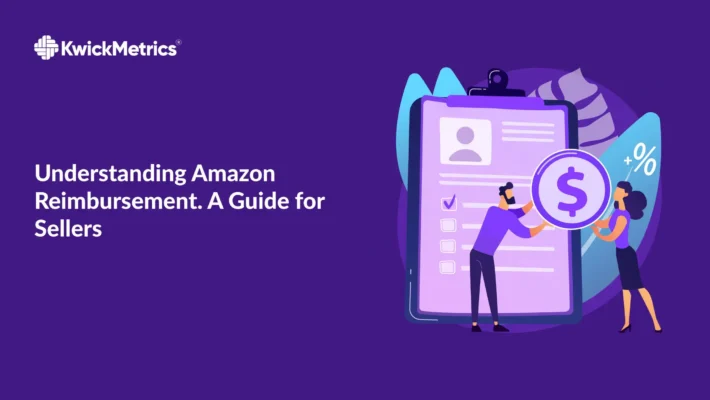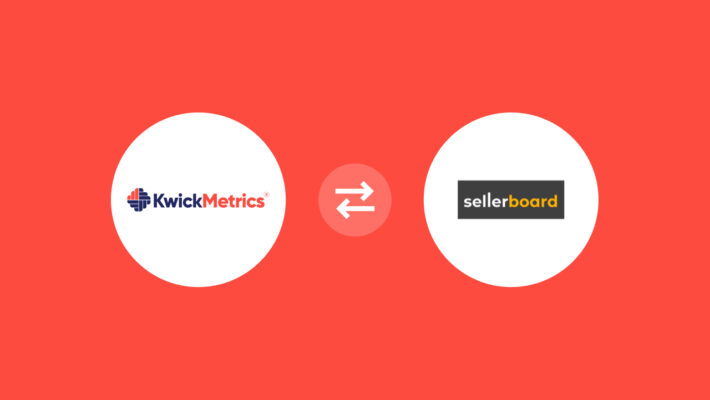FBA Small and Light Changes: Adapting to Low-Price FBA Rates

Table of Contents
- Understanding Amazon’s FBA Small and Light Program
- Transition from FBA Small and Light to Low-Price FBA Rates
- Check How you much have been charged by Amazon under your current shipping Plan
- Key Dates for the Transition in the United States
- Key Dates for the Transition in Other Regions
- Comparing FBA Small and Light with Low-Price FBA Rates
- Try Our KwickMetrics - One Tool with Multiple Solutions!
- Preparing Your Business for the Transition
- The Future of Amazon’s Fulfillment Services
- FAQs in Relation to Fba Small and Light
- Conclusion
- KwickMetrics - The Business Intelligence and Analytics Tool
Ever tried to ship a feather via Amazon’s FBA? Or maybe you’ve dabbled with those mini pocket-sized items, so light they could ride the wind. That’s where Amazon’s ‘FBA Small and Light’ program comes into play.
The beauty of this service is like an all-you-can-eat buffet for sellers dealing in small and light weight products. It’s affordable, uncomplicated and swift. But there are winds of change sweeping across this landscape.
You see, it seems Amazon has decided to give its ‘Small and Light’ program a makeover; transforming it into what we now know as Low-Price FBA rates. This move feels much like swapping out your trusty old bike for a shiny new sports car – exciting but also filled with questions.
Think of this as your roadmap, guiding you along the unfamiliar journey with key transition dates and all.
Understanding Amazon’s FBA Small and Light Program
Prior to delving into the Low-Price FBA rates, it’s essential to grasp the nature of Amazon’s FBA Small and Light program—a specialized initiative designed for sellers dealing with lightweight products. It’s designed to reduce the costs of fulfilling orders, but it doesn’t mean compromising on service quality.
If you’re selling small and light items that are priced under $7, this program can be your golden ticket. You’ll still enjoy the perks of regular Fulfillment by Amazon (FBA) like prime eligibility, customer service from Amazon itself, and access to one of the world’s largest online marketplaces.
The Mechanics Behind The Amazon Small and Light Program
The Amazon Small and Light program isn’t rocket science; in fact, its simplicity is part of what makes it so appealing. As an enrolled seller in the Small and Light program, you ship your inventory directly to Amazon’s fulfillment centers just as usual.
Your eligible products are then stored until purchased by customers. After purchase, they get packaged up into those familiar ‘smile’ boxes or mailers before heading off straight to their new homes across America – no fuss involved.
Affordability at Its Finest
No doubt about it: when compared against standard FBA fees for similar sized goods above $7 price point – there’s a pretty significant saving opportunity here. Your bottom line will thank you if most of your product catalog falls within these parameters.
- You save on Amazon fulfillment costs.
- There’s a reduced Amazon referral fee structure in place for Small and Light items.
- You get to leverage Amazon’s trusted customer service and returns handling, just like regular FBA.
Say Hello To Increased Sales Volume
The lower cost of the program can also let you pass savings onto your customers. With competitive pricing, there is potential for increased sales volume – more affordability often leads to more purchases after all.
And remember, being Prime eligible lets you access even more benefits.
Key Takeaway:
Amazon's FBA Small and Light program is a cost-saving opportunity for sellers of lightweight, inexpensive products. This simple yet effective program allows you to save on Amazon fulfillment costs without compromising on service quality, while potentially boosting sales volume through competitive pricing. Enjoy the usual benefits of regular FBA such as prime eligibility and Amazon’s trusted customer service.
Transition from FBA Small and Light to Low-Price FBA Rates
Amazon, always one for innovation, has decided to phase out the FBA Small and Light program. But don’t panic. In its place comes a more streamlined approach – the Low-Price FBA rates.
The shift isn’t just a name change; it’s Amazon trying to give sellers an even playing field. They’re essentially rolling out the red carpet for smaller items with low price points. It’s like replacing your old-school flip phone with a brand new smartphone – you still make calls, but now there are so many more possibilities.
Why Amazon Low-Price FBA Fee?
This decision didn’t come overnight. Like any good business move, it was about identifying gaps in service delivery and then filling them up efficiently.
Sellers were often left scratching their heads over Amazon fee structures in the Small and Light program because of its complexity. So Amazon thought: “How can we fix this?” The answer lay in simplifying Amazon fees while also giving greater flexibility on item eligibility through introducing Low-Price FBA rates.
New rules of engagement for Low-Price FBA Rates
The introduction of Low-Price FBA rates brings several changes into play which will affect how businesses operate on Amazon:
- No ASIN-level approval is needed anymore – time saved already.
- You’ve got wider selection criteria that let you list products priced as low as $5 (down from the previous $7).
- Changes in Amazon fee structures that could potentially increase your profit margins.
This transition feels a lot like when you upgrade your laptop. Sure, it takes some getting used to – new features, different interfaces – but once you do, things run so much smoother and faster.
So what’s next?
The transition period is crucial for businesses selling on Amazon. It’s about understanding these changes and tweaking strategies accordingly – just like how we adapt to any change in life. But with this move by Amazon, sellers can expect more flexibility while navigating through their e-commerce journey. Check out KwickMetrics for more info.
Check How you much have been charged by Amazon under your current shipping Plan
Key Takeaway:
Think of Amazon's shift from FBA Small and Light to Low-Price FBA rates as swapping your old flip phone for a slick new smartphone. It's all about better, more straightforward fees, no ASIN-level approvals, reduced minimum product prices, and possibly fatter profit margins. But just like getting the hang of a shiny new laptop, sellers gotta wrap their heads around these tweaks.
Key Dates for the Transition in the United States
With Amazon’s announcement of transitioning from FBA Small and Light to Low-Price FBA rates, it’s crucial that sellers mark their calendars with key dates. These dates signal when certain changes will take effect.
The first significant date was February 22, 2023. This is when Amazon stopped accepting new enrolments into the FBA Small and Light program. But don’t fret if you missed this deadline. You can still use other fulfillment options offered by Amazon.
June 1, 2023, marked another critical juncture. On this day, all existing listings under the FBA Small and Light program were automatically transitioned to standard-size Fulfillment By Amazon (FBA) offers at Amazon regular fees.
The Final Phase-Out: September 30th
Sellers should also make a note of September 30th, a particularly important milestone on our timeline because it signals an end-of-era moment: The complete phase-out of inventory storage for items enrolled in the now-defunct FBA Small & Light program.
This means any remaining stock stored under this scheme needs to be removed or disposed of before this cutoff point – so plan your stock management accordingly.
2023 FBA Fee Changes Alert
Last but not least comes November 9th. Now why does that ring a bell? Because as part of these sweeping changes, there’s one more twist in store – Amazon fee changes 2023. Yes, Amazon has announced that it will implement its annual fee change on this date. So make sure you’re ready for the financial implications.
Remember, these dates aren’t just tiny details. They can hit your wallet hard. If you miss ’em, you might wave goodbye to profits or even worse.
Key Dates for the Transition in Other Regions
The shift from FBA Small and Light to Low-Price FBA rates is not limited to the United States. It’s crucial for sellers operating globally to know when this change will take effect in their respective regions.
In Europe, Amazon has already started transitioning towards these new rates. The transition kicked off on February 18, 2023. If you’re a seller in European markets like Germany, France or Spain, make sure your business strategies align with this change. Amazon Seller Central UK provides more detailed information about it.
Moving over to the Asia-Pacific region, Japan witnessed the termination of the FBA Small and Light program on January 14th, 2023. Japan’s official pricing page can give you further insights into how low-priced items are now being handled there.
Australia: A Special Case
If we turn our attention Down Under, Australia is an interesting case as it still operates under both programs – FBA Small and Light and Low-Price FBA Rates. However, it won’t be long before they also fully embrace Low-price FBA Rates too.
This move to lower-cost FBA rates opens up new possibilities for sellers, don’t you think?
Comparing FBA Small and Light with Low-Price FBA Rates
When it comes to Amazon’s fulfillment services, sellers have had two notable options: the FBA Small and Light program, designed for smaller, low-cost items; and the standard Fulfillment by Amazon (FBA) rates. But things are shaking up. So let’s compare these two head-to-head.
Differences in Cost Structure
The primary difference between these programs lies in their cost structure. With FBA Small and Light, sellers enjoyed reduced fees for small-sized products priced under $7. On the flip side, Low-Price FBA Rates apply a standardized fee across all product categories regardless of size or price point that is under $10.
Selling Price Impact
Fees aren’t just about costs—they directly impact your selling price. In general, lower fees allow you to offer competitive prices while maintaining profitability—a winning recipe on Amazon’s marketplace where customers often hunt for bargains.
Packaging Requirements
Another distinction is packaging requirements. The old pal—Small & Light—had specific packing rules aimed at reducing package weight while ensuring safety during transit. Now with Low-Price FBA rates coming into play, we might see more flexibility in packaging standards as long as they adhere to Amazon’s FBA packaging requirements.
Speed of Delivery
Faster delivery often equals happier customers. But the Small and Light program used to offer a slower standard shipping speed (4-5 business days). Will Low-Price FBA Rates give us quicker delivery times? It remains to be seen, but it’s definitely something sellers should keep an eye on.
All these factors are vital in choosing which program suits your products best. As Amazon phases out Small & Light, we’ll need to see how Low-Price FBA rates shape up for smaller items.
A Look at the Bigger Picture
This isn’t just a simple comparison of two programs. It’s about getting the hang of Amazon’s ever-changing fulfillment landscape. As sellers, we need to keep up with these shifts and adapt accordingly for continued success in this constantly evolving world.
Try Our KwickMetrics - One Tool with Multiple Solutions!
Key Takeaway:
Amazon's FBA Small and Light program cuts costs for tiny, inexpensive items, while Low-Price FBA Rates give a flat fee to all products under $10. This lets you price competitively and keep making money. The two programs have different packaging rules, with the former being stricter. Also consider delivery speed; quicker shipping might be available with Low fees.
Preparing Your Business for the Transition
The shift from Amazon’s FBA Small and Light to Low-Price FBA rates can seem daunting, but with some careful planning, your business can make this transition smoothly. Let’s explore how you can do it.
Create a Financial Plan
Start by understanding the financial implications of this change. You might find that low-price items could potentially have higher fees under the new program. To get a grip on these changes, use tools like KwickMetrics, which gives insights into sales analytics and advanced expenses tracking.
This will help you decide if you need to adjust your pricing strategy or even reconsider whether certain products are still viable to sell through Amazon FBA at all.
Analyze Your Inventory Management System
You’ll also want to look at your inventory management system as part of preparing for this switch over. Because each program has different fulfillment requirements, updating inventory processes is crucial so there won’t be any disruptions when switching programs.
If needed, consider using third-party software like KwickMetrics that specializes in inventory management specifically tailored for Amazon sellers. But remember – choose one not mentioned in our exclusion list.
Stay Updated With Key Dates For The Transition
Make sure you’re aware of key dates related to the end of the FBA Small and Light program both in the US market as well as other regions where your products are sold. Amazon Seller Central is an excellent resource for this information.
Having these dates at your fingertips will let you plan and adjust your operations accordingly.
Engage With Other Sellers And Communities
Going through this change by yourself might seem tough, but don’t forget—you’re not alone. Thousands of other sellers and communities are facing the same transition.
The Future of Amazon’s Fulfillment Services
As the eCommerce landscape shifts, so does Amazon’s approach to fulfillment. We’re witnessing a transition from FBA Small and Light to Low-Price FBA rates. But what will this mean for sellers like you? Let’s gaze into the crystal ball.
Embracing Agility in Fulfillment
Gone are the days when one-size-fits-all was an effective strategy for order fulfillment. The future lies in agility – tailoring solutions based on individual seller needs.
This shift is evident with Amazon’s new accelerator program. It highlights how they’re prioritizing flexibility over rigidity, providing tailored support instead of generic packages.
Innovation Meets Seller Needs
Innovation remains at the heart of Amazon’s strategy, focusing on tech advancements that streamline operations and cut costs.
A case in point is their utilization of AI tech such as ML models to anticipate sales patterns. This lets them store inventory more efficiently – something every seller can appreciate.
Paving Way For Sustainability
Sustainability isn’t just a buzzword anymore; it has become a mandate. And guess who’s leading by example? You guessed it right: our e-commerce giant, Amazon.
Their commitment towards reducing carbon footprint through initiatives like The Climate Pledge reflects how eco-consciousness will shape the future of fulfillment.
Enhanced Customer Experience
Customer experience has always been a cornerstone for Amazon. In the future, expect more focus on delivering products faster and resolving customer issues even quicker.
Their recent moves like opening new sortation centers, are testament to their commitment towards enhancing customer satisfaction.
The journey ahead may be full of unknowns, but with adaptability at its core, it’s clear that Amazon’s vision for the future is all about catering to evolving seller needs while making online selling easier and more profitable.
Key Takeaway:
Amazon's fulfillment future is pivoting towards agility and tailored solutions for individual sellers. Innovations like AI are streamlining operations while sustainability initiatives showcase Amazon's commitment to reducing its carbon footprint. All this, coupled with an increased focus on enhancing customer experience, makes the path ahead exciting for sellers.
FAQs in Relation to Fba Small and Light
What Items Are Eligible for Low-Price FBA Fees?
The new fees will automatically apply to all products priced below $10.
What changes have been made in the fee structure for 2023?
In 2023, Amazon has introduced the Low-Price FBA Rates, aiming to better accommodate sellers with lower-priced items and improve overall cost-effectiveness.
Are there any considerations for sellers using Amazon’s FBA Small and Light program?
Sellers transitioning from the FBA Small and Light program to Low-Price FBA Rates should carefully review the changes in fees and adjust their strategies accordingly.
Can sellers provide feedback on the new fee structure?
Yes, Amazon encourages sellers to provide feedback on the new fee structure through their seller account and participation in relevant forums.
What steps can sellers take to optimize their costs under Low-Price FBA Rates?
Sellers can optimize costs by reviewing their product pricing strategies, exploring bundling options, and leveraging tools like KwickMetrics for analytics and insights.
How do Low-Price FBA Rates compare to standard FBA fees?
Low-Price FBA Rates typically result in an average per-unit cost that is lower than standard FBA fees, providing potential savings for sellers.
How long is shipping for Low-Price FBA Rates?
Fulfillment times can vary but generally speaking, products shipped through the ‘Low-Price FBA Rates’ option typically arrive as same as Standard FBA Shipping after order confirmation. The shipping speed is faster when compared to Amazon FBA Small and Light.
Conclusion
Amazon’s FBA Small and Light program is transforming. But it’s not about losing; it’s all about adapting.
The shift to Low-Price FBA rates brings its own challenges, but also opportunities.
Key dates for this transition differ across regions. You need to be cognizant of when the switch will affect your business specifically.
Comparing the existing and new programs can help you decide which one is more suitable for your requirements. The key here is being informed before making any hasty decisions.
In conclusion, embrace change as an inevitable part of growth in Amazon’s ever-evolving marketplace landscape. Stay adaptable with a keen eye on what lies ahead – that’s how you continue thriving amidst shifts like these from FBA Small and Light to Low-Price FBA rates.




